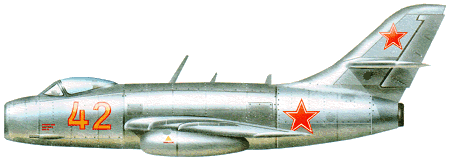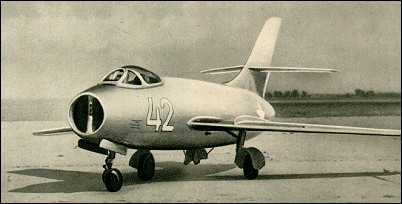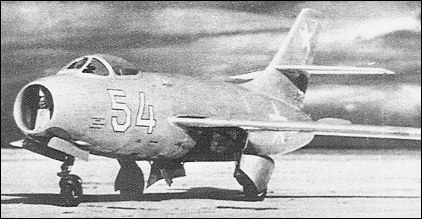|
| The Yakovlev OKB's response to the March 1946 requirement for a Rolls-Royce Derwent-powered Mach=0.9 "frontal" or general-purpose tactical fighter suitable for use from existing unpaved airfields was the Yak-30. Derived from the Yak-25 from which it differed primarily in having wings sweptback 35° at quarter chord, the Yak-30 retained the fuselage, tail surfaces and undercarriage of the earlier fighter fundamentally unchanged, together with the three-NR-23 cannon armament. Powered by a 1590kg RD-500 turbojet, the first of two Yak-30 prototypes was flown on 4 September 1948. The second prototype, the Yak-30D, which joined the flight test programme early in 1949, had a 38cm section inserted in the aft fuselage, revised mainwheel doors forming a large section of the fuselage skinning, Fowler-type flaps in place of split flaps, increased fuel and ammunition capacity, and changes to the oxygen system and radio equipment. The Yak-30D was also fitted with air brakes on the aft fuselage. Normal loaded weight (without external fuel) was increased by 110kg. Although the modifications introduced by the Yak-30D eradicated several shortcomings displayed by the first prototype, the first production deliveries of the superior MiG-15 were already taking place by the time that the improved version of the Yakovlev fighter entered flight test, and the results of NIl V-VS trials were, therefore, little more than academic.

| MODEL | Yak-30 |
| CREW | 1 |
| WEIGHTS |
| Take-off weight | 3330 kg | 7341 lb |
| Empty weight | 2415 kg | 5324 lb |
| DIMENSIONS |
| Wingspan | 8.65 m | 28 ft 5 in |
| Length | 8.58 m | 28 ft 2 in |
| Wing area | 15.10 m2 | 162.53 sq ft |
| PERFORMANCE |
| Max. speed | 1010 km/h | 628 mph |
| Ceiling | 15000 m | 49200 ft |
| Range w/max.fuel | 1720 km | 1069 miles |
 | A three-view drawing (1663 x 1173) |
| Unknown, 22.03.2017 12:24 It's not a Yak-30. reply | | choqing, 21.06.2011 06:15 while the Mig-15 plane was being
beaten, in a 12.45-to-1.00 loss-kill ratio with the
USAF F-86B /C "Sabre" jets over the embattled skies of North Korea, in 1951-thru-1953. reply | | bombardier, e-mail, 24.05.2011 11:01 Strikingly similar to a MiG-15 but smaller reply | | Leo Rudnicki, e-mail, 11.08.2009 15:15 The La-15 had an edge in performance over the MiG-15, but the MiG design was easier to build. The Yak was third, an also-ran. I study history but have no PhD. Soviets claimed a 2 to 1 kill ratio for Soviet pilots that weren't there. Officially. At the time. And it does look like a sabre when I take my glasses off. sorta. reply | |
| | Jim Lloyd, e-mail, 11.08.2009 14:27 As stated, the F-86B actually became the F-100 and the F-86C was the YF-93A used for testing intakes and such. To say Yak-30D was en exact copy of the F-86 is ludicrous, the F-86 was a far superior plane. Dr. Stage should study his history. reply | | mert, e-mail, 28.01.2009 13:47 its ilke mig 15 reply | | RR_man, 07.06.2008 14:54 I cannot believe how off the mark some people like Dr. Stage can be! No USAF F-86B /C ever flew in Korea. The 'B' programme was stillborne and 'C' was cancelled. Only the A /E /F varients were flown and the kill ratios of F-86 to MiG-15 was closer to 2:1. The majority of F-86 kills coming in '52 on when the balance swing in the favour in the USAF FEAF, and truly demonstrating the 'superior skills' of the F-86 pilots by shoting down MiGs when landing and taking off. This is how the USAF made most of their double and triple aces! The MiGs were not tasked with attacking F-86s anyway (until '53 when 'F' variants showed up with bombs) but shooting down bombers at all costs. But by the end of '52 operational pilots at Antung was as low sa 48 pilots. They were massively outnumbered! Initial flights of the Chinese proved ineffetive and did not show any effectivenes till'58. Korean pilots flew hardly if at all.
The F-86 'reverse-engineered' aircaft was given to the Sukhoi office and appeared as the stillborn 'S-1' programme.
Selection at this time for competing military programmes [in the USSR] if very close came down to political lobbying (just as in the US). Hence the Mig-15 selection - via Artyom Mikoyan's connections. reply | | Sgt.KAR98, 13.11.2007 03:19 Interesting how this plane is similar to the MiG-15,like the La-15.
Why the MiG-15 was choosed instead of this or the La-15? reply | | Admin, 12.11.2007 09:37 Thank you for your comments, but... As historical records say now the 12:1 loss /kill ratio in Korea was nothing more than American propaganda. If you don't believe Russian sources (that had a lot of propaganda too ;), try to read more modern publications, such as Squadron /Signal or Osprey's< /a>. Even according to them, the loss /kill ratio was much different.reply | | Dr. Nikholas M. Stage-PHD., e-mail, 11.11.2007 19:20 The Yak-30D was more than equal in the December of 1949 "fly-off" with the Mig-15, held in Moscow
on December 11th-through-16th of 1949.
This plane was to later to achieve a "max-ceiling" of over 56,000
ft. in altitude, while the Mig-15 plane was being
beaten, in a 12.45-to-1.00 loss-kill ratio with the
USAF F-86B /C "Sabre" jets over the embattled skies of North Korea, in 1951-thru-1953.
Also, with slight modifications, the Yak-30D would have
been an exact "copy" of the USAF F-86.
The Mig-15 had an over-sized vertical tail assembly:
the F-86 Sabre Jet, and the Yak-30D, did not.
Stalin was pushing too hard. The results; USAF and UN
air-to-air combat supremacy in the 1950-1953 Korean War. reply |
|
Do you have any comments?
|
| 
COMPANY
PROFILE
All the World's Rotorcraft
|









